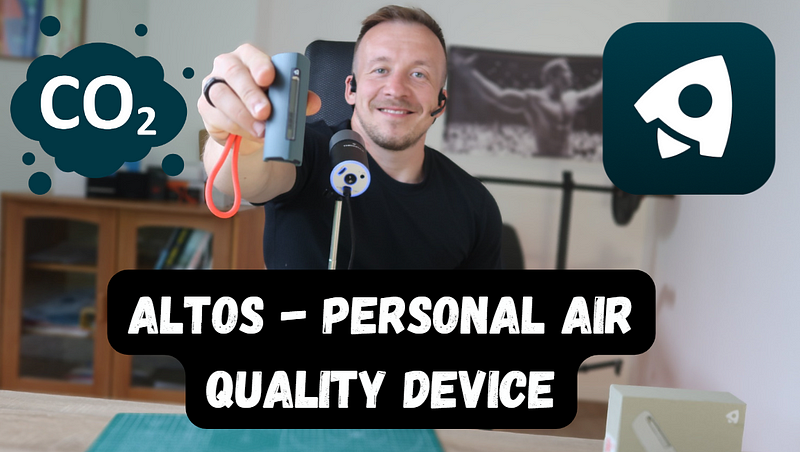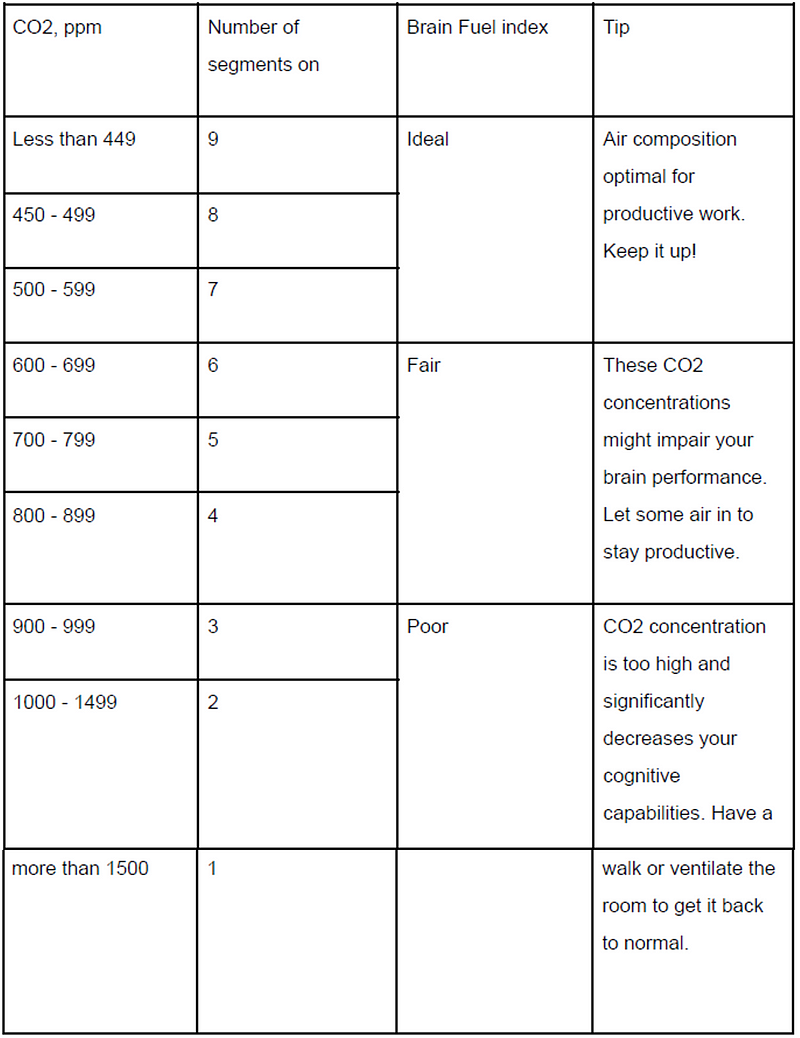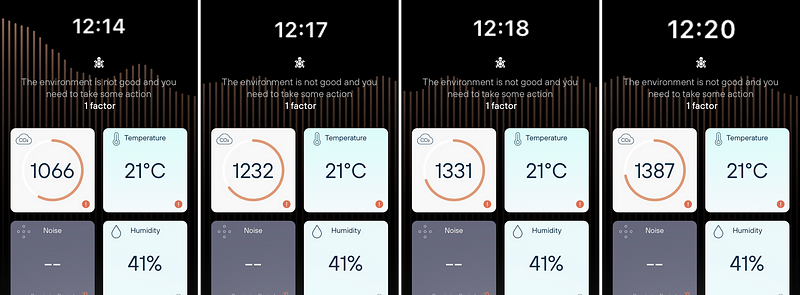Altos — personal air quality device — review
We have a ventilation system (i.e. an automatic air exchange system) in our house without CO2 sensors. I was thinking of integrating them…

We have a ventilation system (i.e. an automatic air exchange system) in our house without CO2 sensors. I was thinking of integrating them so that the recirculation is really only triggered “when the air is too stuffy”. As I currently only have the ventilation timer set to start and stop.
I haven’t given up on the idea of sensors, but I’ve also started to think in the wider context of the quality of the air I breathe. After all, I live in various enclosed spaces — offices, meeting rooms, gyms, cars, my parents’ house, etc.
In this article, I would like to focus on air quality in this context:
- Why measure air quality?
- What is Altos?
- Testing Altos devices in different scenarios — at home, in the gym, in the office, etc.
- Conclusion
Why measure air quality
We all breathe air. Air is a mixture of gaseous substances, mainly nitrogen, oxygen, argon and carbon dioxide (CO2).

Breathing produces CO2 and therefore increases its concentration, especially in enclosed spaces, measured in ppm (parts per million — the number of particles of a given substance in a million total particles of the environment).
CO2 levels affect the human body, particularly the brain, and can therefore affect the following key processes/metrics:
- Cognitive performance — this 2015 study [1] says that there is a statistically significant reduction in “decision-making performance” in test subjects as CO2 levels increase from a baseline of 600 parts per million (ppm) to 1000 ppm and 2500 ppm.
- Physical performance — I haven’t actually found any decent scientific support for this, but I know only too well how much I dislike stale air, especially in the gym.
- Sleep — according to this study [2], the ventilated bedroom group had better quality sleep than the non-ventilated group.
High levels of CO2 in the air can have a negative effect on people’s sleep, cognitive performance, and physical activity. Conversely, reducing CO2 levels in a room can help improve these factors and increase the overall quality of life. It is therefore important to ensure proper ventilation, especially in enclosed spaces with low air volumes and high occupancy.
We don’t need to go into the details of the scientific studies, it’s enough to remember our own feelings in a stuffy office/gym/bedroom.
Below are a few images to illustrate that higher levels of CO2 have a negative effect on humans.

What is Altos?
Altos is a pocket-sized device that measures the following environmental metrics:
- CO2,
- Temperature,
- humidity.
I was under the impression from the getaltos website that it also measures ambient noise levels, but only via mobile phone.

It then interprets the measured metrics (especially C02) in the form of “BrainFuel” on a scale of 1–10 (1 — worst, 10 — best). This metric is the central information of the application and also of the device display.
General parameters
Here are some general parameters of the device:
- Battery — 560 mAh — it should last up to 6 months on a single charge, charging takes about 2–3 hours.
- Display — the device has a very simple bar display that shows the current BrainFuel level.
- Connectivity — although the device can work independently of a mobile phone (with the values displayed on the screen), it is primarily designed to work in conjunction with it, via a Bluetooth interface.
Interpretation of BrainFuel
Brainfuel is, as mentioned above, a scale of 1–10. The individual CO2 ranges, the verbal rating of ideal/fair/poor as “Brain Fuel Index” and the tip correspond directly to this scale.

The Application
The Altos app (iOS and Android) is a very simple extension for physical devices. Pairing is very easy and the app itself is very simple. An illustration of the initialization and basic setup process is shown in the images below:

The base is the current measurement with information in tile form. It is also possible to access the history of the reading, which only shows the Brainfuel values. At the same time, these values are only recorded if the device is connected to the phone at the time of measurement. In other words, if you switch to airplane mode for the night, you are out of luck:

The test and my scenarios
If we spend most of our time outside closed boxes (buildings and cars), we don’t need to measure CO2 (yet). According to the WHO Europe 2013 report, people spend up to 90 % of their time indoors. I believe this figure, especially in the winter months.
But given how quickly indoor air can be “exchanged”, measuring CO2 is something that makes sense in the context of optimizing the human quality of life.
Open Office
Open office was actually a pleasant surprise for me, as I didn’t measure any high CO2 levels. However, this will vary from office to office, depending on HVAC, number of people, size, etc.
Meeting room
Over the past few weeks I’ve been holding workshops with a large number of people in a small meeting room with no windows. In addition, the ventilation was often turned off because of the “cold air”.
Unfortunately, I was waiting for the Altos device to arrive, so I didn’t get a chance to measure anything. However, another opportunity soon arose at a training session where there were about 8 of us (the capacity of the meeting room is 10 according to the menu). I will describe the situation chronologically below.

- 8:57 — Start of training, 2 vents open.
- 9:49 — CO2 rising and approaching the recommended maximum of 1000 ppm.
- 9:56 — pause and ventilation by fully opening the window, then CO2 drops.
- 10:12 — Training resumes with windows closed due to outside noise. Followed by a rapid rise in CO2.
- 10:33 — Peak at 1700 ppm. I personally feel “heavy headed”.
Car
Although I’m a big fan of cycling, I also drive. While I didn’t notice a significant increase in CO2 in my car with the ventilation on in “automatic mode”, sittingin the back of an older car provided an interesting test.
The ventilation was on, but I don’t think it was working at 100%. There were 4 people in the car and the fact that the Altos was placed in the back of the car, where there are fewer fans, certainly played a part. I literally watched the CO2 build up minute by minute:

Gym
I go to a relatively small fitness center. Sometimes I meet somebody who gets too much “wind on his neck” and decides to turn off the air conditioning. This immediately results in an increase in CO2, as he can see in the picture below.

I’m not sure if this is no longer a nocebo effect… but I find it harder to exercise at higher CO2 levels, especially with some of the more challenging exercises where I feel I need to increase my oxygen supply.
Cottage with wood stove
Staying in a cottage with a fire in a wood-burning stove was also an interesting test. Fire eats oxygen and produces CO2 in a similar way to humans. I don’t have immediate screenshots, but I’m sharing the time-lapse statistics, which I’ll comment on below.

A verbal comment on the context of the action in the cabin would be as follows. The fire had been burning in the cabin since the afternoon, but it wasn’t until 20:00 that the cabin was basically ventilated, the doors opened, etc. Around 8pm, the occupants of the cabin (5 people) moved inside. The combination of 5 people and a burning fire pushed the BrainFuel to level 2, which corresponds to a CO2 level of 1000–1499. Around 10pm I opened the vent, the fire went out and the readings came down to acceptable levels. Between 7am and 8am we got up and reignited the fire, which quickly caused the BrainFuel levels to drop.
I’ll come back to the noise that the app measures through the phone’s microphone. I just came across the following tweet at the time of writing:
It talks about how noise reduces productivity by up to 5%, according to a certain study [3] which is 80 pages long (so I haven’t read it).
So I enabled the app to use the microphone to monitor noise. According to the orange dot in the top iOS bar, this only happens when the app is in use, so it’s not listening to you, at least not all the time 😉 .

Reviews of Altos
Altos is a small handheld device that gives you an idea of the state of your air quality. It has a battery life of months, which is very impressive in today’s world of constantly draining mobile phones/watches etc. On the negative side, it’s a shame that the device doesn’t have an internal memory that can be synchronized when it’s connected to a Bluetooth mobile phone.
It is a rather expensive device ($199).
All in all, I would sum it up like this:
[+] 👍
- Compactness of the device
- Accuracy — judging by the context of the measurement
- Battery life in months
- Immediate notifications
[-] 👎
- Requirement of a BT-enabled mobile phone
- Price
- Long delivery time in my case — 2 months (EU)
Conclusion
In the name of “having the data to make the right decision”, I pay tribute to Peter Drucker’s slogan:
“You can’t improve what you don’t measure”.
Altos paraphrases the same slogan on its website:

It doesn’t mean you need Altos. It’s a nice little gadget that can impress your friends and start an interesting conversation. At its core, however, you could probably get away with using an ordinary CO2 meter for a cheaper price and monitoring the readings ‘offline’.
In the context of my current test, I’d like to highlight a certain awareness that we can sometimes blame something we can’t see — exhaled air — for any ‘indoor fatigue or brain fog’. It’s nice to have some data to back this up, and it’s nice to get automatic warnings. And it’s nice to be able to go outside for a breather from time to time. So go for it 😉



